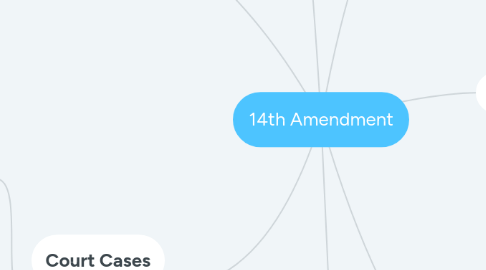
1. Definition: Prevented government from denying any citizen their rights or protection
1.1. Equal protection is th idea that no one shall be denied rights based on race, religion, sex, or nationality.
2. Court Cases
2.1. 1857: Dred Scott v. Standford
2.1.1. Dred Scott was an enslaved African American who traveled with his owner. When his owner died, Dred sued him for his freedom.
2.1.1.1. The Supreme Court ruled that because Dred Scott was a descendant of an enslaved African, he was not a citizen. Therefore, he had no right to sue and is considered property.
2.2. 1954: Brown v. Board of Education
2.2.1. People questioned whether having separate schools was fair and constitutional. They argued that segregation based on race violated the 14th amendment.
2.2.1.1. The Supreme Court ruled that separate schools were unequal. A year later, the Supreme Court made a decision allowing students of all races to attend school together.
2.3. 1896: Plessy v. Ferguson
2.3.1. Plessy was arrested for sitting in a white zone only spot. He felt this violeted the 14th amenment.
2.3.1.1. The Supreme Court ruled that this was okay because it was separate but equal.
3. Education Acts
3.1. 1972: Indian Education Act
3.1.1. This act provided money and services to Native American School
3.1.2. Native Americans weren't considered U.S citizens because they lived on
3.2. 1997: Indivuals with Disabilities Education Act
3.2.1. This act provides protection to people with physical or mental disabilities.
3.2.2. This makes sure kids with disabilities receive the education that best fits them and their needs.
4. Current Events
4.1. Racial Profiling
4.1.1. Racial profiling is discrimination based on how you look, your skin color, and ethnicity
4.1.2. One example, is after September 11 many Muslims were being discriminated and attacked
4.1.3. https://www.washingtonpost.com/posteverything/wp/2014/12/15/racial-profiling-has-destroyed-public-trust-in-police-cops-are-exploiting-our-weak-laws-against-it/?utm_term=.521896a7417c
4.1.3.1. This article is about how racial profiling is being shown from law enforcement. The includes how it is seen throughout our cities.
4.2. Same Sex Marriage
4.2.1. In June 2015, people of the same sex were allowed to get married
4.2.2. Banning same sex marriage was unconstitutional and marriage can be bewteeen people of the same sex.
5. Origin
5.1. Black Codes
5.1.1. Passed in 1865-1866, these state and local laws limited the rights of freed blacks.
5.1.2. These laws forced racial segregation between races.
5.1.3. Black Codes prevented African Americans from using the same bathroom, going to the same schools, and drinking from the same water fountain as whites.
6. Equal Protection
6.1. 1963: Equal Pay
6.1.1. Equal pay act focused more on women because this protection made it illegal for companies to pay women less than men for doing the same work.
6.1.2. This states that women and men should receive equal pay for doing the same work.
6.2. 1990: Americans with Disabilities Act
6.2.1. This act prevents companies and work places from discriminating people with disabilities
6.2.2. This guarantees an equal opportunity for people with disabilities in jobs and allows them to be apart of the economy.
6.2.3. For example, their needs to be a ramp for people on wheel chairs so those with disabilities have equal access to places.
7. Ending Racial Discrimimation
7.1. 1964: Civil Rights Act
7.1.1. This act outlaws discrimination and would end discrimination in public places. This also ended discrimination based on sex, religion, and national origin.
7.2. 1965: Voting Rights Act
7.2.1. This act allowed for all people, no matter race to vote.
7.2.2. This also banded poll taxes and ended literacy tests.
7.2.3. This was also passed to enforce the 15th amendment, which allowed all male citizens to vote regardless of race.

